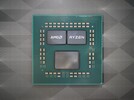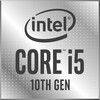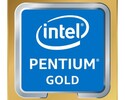AMD Ryzen 7 5700U vs Intel Core i5-10310U vs Intel Pentium Gold 6405U
AMD Ryzen 7 5700U
► remove from comparison
The AMD Ryzen 7 5700U is an APU of the Lucienne product family designed for leaner laptops. The Ryzen features eight Zen 2 cores clocked at 1.8 GHz (base clock speed) to 4.3 GHz (Boost) as well as a Vega 8 iGPU. Thread-doubling SMT tech is enabled in this CPU for up to 16 concurrent processing threads.
Architecture
In spite of what its name may suggest, Ryzen 7 5700U is not a Zen 3 part, meaning this is a Ryzen 4000 series mobile processor in disguise. Nevertheless, the CPU is manufactured on the modern 7 nm TSMC process and its performance as well as energy efficiency figures are very strong compared to what Intel currently has to offer in this segment.
The Ryzen 7 features 8 MB of Level 3 cache. Its built-in memory controller is designed to work with dual-channel DDR4-3200 or quad-channel LPDDR4-4266 RAM. Unlike the desktop Ryzen 5000 processors, Ryzen 7 5700U does not support PCI-Express 4.0, meaning those speedy NVMe SSDs will be limited to read/write rates of 3.9 GB/s.
The Ryzen gets soldered directly to the motherboard (FP6 socket) and is thus not user-replaceable.
Performance
The average 5700U in our database is in the same league as the Ryzen 7 4800U, Ryzen 7 PRO 5850U, Core i7-1365U, as far as multi-thread benchmark scores are concerned.
Thanks to its decent cooling solution and a long-term CPU power limit of 35 W, the Schenker VIA 15 Pro is among the fastest laptops built around the 5700U that we know of. It can be roughly 50% faster in CPU-bound workloads than the slowest system featuring the same chip in our database, as of August 2023.
Graphics
In addition to its eight CPU cores, Ryzen 7 5700U features a Radeon RX Vega series graphics adapter with 8 CUs (= 512 shaders) running at up to 1,900 MHz. This iGPU trails behind the 96 EU Intel Iris Xe Graphics G7 in synthetic benchmarks, yet its real-world performance is good enough for many games released in 2020 and 2021 at reasonable resolutions (up to Full HD 1080p) and low to medium quality. As the Vega has no VRAM of its own, it is paramount that fast system RAM is used.
The graphics adapter definitely supports UHD 2160p monitors at 60 Hz, and will gladly HW-decode AVC, HEVC and VP9-encoded videos. There is no AV1 support here though.
Power consumption
This Ryzen 7 has a default TDP, also known as the long-term power limit, of 15 W; laptop makers are free to change that to anything between 10 W and 25 W, with clock speeds and performance changing accordingly as a result. Most companies will go for a higher value to extract more performance out of the APU. By choosing the lowest value, it will be possible to build a passively cooled system around the chip, too.
The 7 nm TSMC process the R7 5700U is built with makes for decent, as of late 2022, energy efficiency.
Intel Core i5-10310U
► remove from comparison
The Intel Core i5-10310U is a power efficient quad-core SoC for notebooks based on the Comet Lake (CML-U) generation and was announced in August 2019. Compared to the similar Whiskey Lake processors (e.g. Core i5-8665U), the only difference is support for higher memory speeds (DDR4-2666 vs 2400) and two additional cores in the top model (not in this i5). The processor cores are clocked between 1.7 and 4.4 GHz (unverified). Thanks to HyperThreading 8 threads can be used. Compared to the faster i5-10510U, the level 3 cache was reduced from 8 to 6 MB. More information on Comet Lake and all the models and articles on it can be found here. The CPU supports the professional management features under the vPro umbrella.
The integrated graphics adapter however is still the same as in the previous generations. It should be still called Intel HD Graphics 620 and clock from 300 - 1100 MHz in the i5. Furthermore, the SoC integrates a VP9 and H.265 de- and encoder and an integrated dual channel DDR4-2666 / LPDDR4x 2933 / LPDDR3-2133 memory controller.
Performance
The average 10310U in our database is not really any different than other quad-core laptop CPUs running at similar clock speeds, such as the Ryzen 5 3450U or the Core i5-1035G4.
Your mileage may vary depending on how high the CPU power limits are and how competent the cooling solution of your system is.
Power consumption
This Core i5 has a default TDP (also known as the long-term power limit) of 15 W, a value that laptop manufacturers are free to change to anything between 10 W and 25 W with clock speeds and performance changing correspondingly. Perhaps more importantly, short-term power consumption can be as high as 80 W or even 90 W as far as 10th gen Comet Lake U chips are concerned, making passively cooled designs unlikely.
This Intel processor is manufactured on a fairly old, as of late 2022, 14 nm Intel process for subpar energy efficiency.
Intel Pentium Gold 6405U
► remove from comparison
The Intel Pentium Gold 6405U is a power efficient entry-level dual-core SoC for notebooks based on the Comet Lake (CML-U) generation and was announced in October 2019. Compared to the similar Whiskey Lake Pentium 5405U processors, the difference is the higher clock speed (+100 MHz) and support for faster memory. The processor cores are clocked at 2.4 GHz (no Turbo). Thanks to HyperThreading 4 threads can be used. More information on Comet Lake and all the models and articles on it can be found here.
Due to the 100 MHz higher clock speed, the Pentium Gold 6405U should be slightly faster than the old Pentium 5405U and therefore in the entry level of mobile processors. The missing Turbo and only two cores are definitely a downside and therefore the CPU is best used for simple tasks like browsing and office programs. Compared to the faster Core i3, i5 and i7 Comet Lake models, the Pentium does not support SSE (2).
The integrated graphics card is still the same as in the previous generations. It is called only Intel UHD Graphics but is still the same Intel UHD Graphics 610 like in the Pentium 5405U. Furthermore, the SoC integrates a VP9 and H.265 de- and encoder and an integrated dual channel LPDDR3-2133/DDR4-2400 memory controller (compared to DDR4-2666 in the faster Core i3).
The chip is still produced in the 14nm++ process as Whiskey Lake. The TDP (PL1) is specified at 15 Watts but can be lowered to 12.5 Watt although the CPU then only runs at 800 MHz.
| Model | AMD Ryzen 7 5700U | Intel Core i5-10310U | Intel Pentium Gold 6405U | ||||||||||||||||||||||||||||||||||||||||||||||||||||||||||||||||||||||||||||||||||||||||||||
| Codename | Lucienne-U (Zen 2) | Comet Lake-U | Comet Lake-U | ||||||||||||||||||||||||||||||||||||||||||||||||||||||||||||||||||||||||||||||||||||||||||||
| Series | AMD Lucienne (Zen 2, Ryzen 5000) | Intel Comet Lake | Intel Comet Lake | ||||||||||||||||||||||||||||||||||||||||||||||||||||||||||||||||||||||||||||||||||||||||||||
| Series: Comet Lake Comet Lake-U |
|
|
| ||||||||||||||||||||||||||||||||||||||||||||||||||||||||||||||||||||||||||||||||||||||||||||
| Clock | 1800 - 4300 MHz | 1700 - 4400 MHz | 2400 MHz | ||||||||||||||||||||||||||||||||||||||||||||||||||||||||||||||||||||||||||||||||||||||||||||
| L1 Cache | 512 KB | 256 KB | 256 KB | ||||||||||||||||||||||||||||||||||||||||||||||||||||||||||||||||||||||||||||||||||||||||||||
| L2 Cache | 4 MB | 1 MB | 1 MB | ||||||||||||||||||||||||||||||||||||||||||||||||||||||||||||||||||||||||||||||||||||||||||||
| L3 Cache | 8 MB | 6 MB | 2 MB | ||||||||||||||||||||||||||||||||||||||||||||||||||||||||||||||||||||||||||||||||||||||||||||
| Cores / Threads | 8 / 16 | 4 / 8 | 2 / 4 | ||||||||||||||||||||||||||||||||||||||||||||||||||||||||||||||||||||||||||||||||||||||||||||
| TDP | 25 Watt | 15 Watt | 15 Watt | ||||||||||||||||||||||||||||||||||||||||||||||||||||||||||||||||||||||||||||||||||||||||||||
| Technology | 7 nm | 14 nm | 14 nm | ||||||||||||||||||||||||||||||||||||||||||||||||||||||||||||||||||||||||||||||||||||||||||||
| max. Temp. | 105 °C | 100 °C | 100 °C | ||||||||||||||||||||||||||||||||||||||||||||||||||||||||||||||||||||||||||||||||||||||||||||
| Socket | FP6 | BGA1528 | FCBGA1528 | ||||||||||||||||||||||||||||||||||||||||||||||||||||||||||||||||||||||||||||||||||||||||||||
| Features | DDR4-3200/LPDDR4-4266 RAM, PCIe 3, MMX, SSE, SSE2, SSE3, SSSE3, SSE4A, SSE4.1, SSE4.2, AVX, AVX2, BMI2, ABM, FMA, ADX, SMEP, SMAP, SMT, CPB, AES-NI, RDRAND, RDSEED, SHA, SME | LPDDR3-2133/DDR4-2666/LPDDR4-2933 RAM, PCIe 3, 4 GT/s bus, vPro, MMX, SSE, SSE2, SSE3, SSSE3, SSE4.1, SSE4.2, AVX, AVX2, BMI2, ABM, FMA, ADX, VMX, SMX, SMEP, SMAP, MPX, EIST, TM1, TM2, HT, Turbo, SST, AES-NI, RDRAND, RDSEED, SGX | Dual-Channel DDR4 Memory Controller, HyperThreading, AVX2, Quick Sync, Virtualization, AES-NI | ||||||||||||||||||||||||||||||||||||||||||||||||||||||||||||||||||||||||||||||||||||||||||||
| iGPU | AMD Radeon RX Vega 8 (Ryzen 4000/5000) ( - 1900 MHz) | Intel UHD Graphics 620 (300 - 1150 MHz) | Intel UHD Graphics 610 (300 - 900 MHz) | ||||||||||||||||||||||||||||||||||||||||||||||||||||||||||||||||||||||||||||||||||||||||||||
| Architecture | x86 | x86 | x86 | ||||||||||||||||||||||||||||||||||||||||||||||||||||||||||||||||||||||||||||||||||||||||||||
| Announced | |||||||||||||||||||||||||||||||||||||||||||||||||||||||||||||||||||||||||||||||||||||||||||||||
| Manufacturer | www.amd.com | ark.intel.com | ark.intel.com | ||||||||||||||||||||||||||||||||||||||||||||||||||||||||||||||||||||||||||||||||||||||||||||
| $161 U.S. |
Benchmarks
Average Benchmarks AMD Ryzen 7 5700U → 100% n=2
Average Benchmarks Intel Core i5-10310U → 77% n=2
Average Benchmarks Intel Pentium Gold 6405U → 36% n=2
* Smaller numbers mean a higher performance
1 This benchmark is not used for the average calculation













